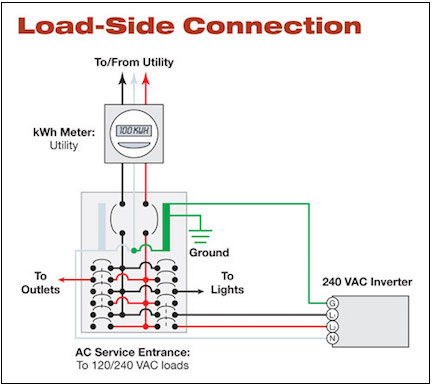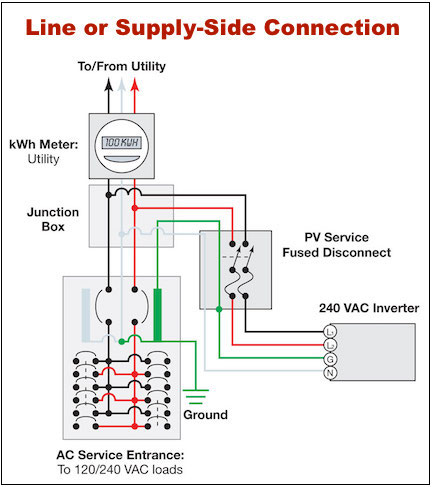How To Connect PV Solar To Utility Grid
Here are design tips for methods of PV system utility interconnection. The purpose of this article is to give you a basic understanding of the concepts and rules for connecting a solar panel system to the utility grid and the household electrical box or meter. The utility connection for a PV solar system is governed by the National Electrical Code (NEC) Article 690.64. Always refer to the NEC code in effect or consult a licensed electrician for safety and accuracy.
There are two basic approaches to connecting a grid-tied solar panel system, as shown in the wiring diagrams below. The most common is a "LOAD SIDE" connection, made AFTER the main breaker.
The alternative is a "LINE OR SUPPLY-SIDE" connection made BEFORE the main breaker. This type of interconnection is used if the main service panel is too small, or for whole home backup systems with solar and battery storage.
Sample drawings for Load and Supply-Side Grid Connections
 |
 |
Load Side Connections
In simple terms, a Load Side connection is made AFTER the main breaker in the electrical panel; this is the most common method of connecting. A new circuit breaker(s) will be added to the electrical panel. The circuit breaker will be dual-pole or double-space, and it will be located in a position farthest from the main breaker. Then the wires from the PV solar system will be connected to this new solar breaker. An adequately sized PV service disconnect box must be used before making the connection. Some inverters include the disconnect or an external disconnect can be added cheaply.
When using a load-side connection, two NEC rules govern the size allowed based on the electrical panel size and the solar output size. Both rules must be satisfied to meet Code when using a load-side connection.
RULE 1
Known as the 120% rule, the solar circuit breaker can be no more than 20% of the main electrical panel rating. The electrical panel rating Amps (A), or Busbar rating, is the manufacturer rating typically found on a label. The circuit breaker is technically called an Over Current Protection Device, or OCPD.
For example, a 200 Amp electrical panel is rated with a 200A busbar, and commonly has a 200A Main OCPD breaker. The 120% Rule back-feed limit for solar is calculated as:
- MAX SOLAR BACKFEED CALCULATION:
- (BUSBAR RATING x .20) + (BUSBAR - MAIN OCPD) = MAX PV (A)
- (200A x .20) + (200A - 200A) = 40A MAX BACKFEED SOLAR
- Therefore, 40A is the maximum solar output for a 200A panel with a 200A main OCPD, unless de-rated
Now, the main breaker can be changed to a smaller size (e.g. de-rated) to make room for more solar. Here is an example of a de-rated electrical panel to handle a larger solar system:
- (BUSBAR RATING x .20) + (BUSBAR - MAIN OCPD) = MAX PV (A)
- (200A x .20) + (200A - 175A) = 65A MAX BACKFEED SOLAR
- De-rating the main breaker to 175A in this example, an additional 25A is freed up for use by solar
RULE 2
The solar breaker OCPD must be at least 125% of system output. System output is determined by the total output Amp rating of the inverter(s).
- Example A: if inverter output is 32A, then 1.25 x 32A = 40A minimum solar breaker size.
- This would also satisfy Rule 1 for a 200A electrical panel.
- Example B: if inverter output is 34A, then 1.25 x 34A = 42.5A minimum solar breaker size.
- This does not satisfy Rule 1 for a 200A panel, therefore de-rate the Main panel breaker.
It may not be possible to meet the NEC interconnection rules for older, smaller, or full electrical panels, e.g. 100A or 125A, with a larger PV solar array. You may have the option to replace the existing electrical panel with a new, larger box, or use the alternative Line Side Connection. For quick reference, you can also view this table showing the Maximum Connected PV Inverter Watts for various breaker box amp ratings.
Line or Supply-Side Connection
As with most things electrical, there are many ways to do the job. There is an ALTERNATIVE UTILITY CONNECTION called a “Supply or Line Side" connection. This connection is made BEFORE the main breaker. A junction box is added between the utility meter and the main service panel. Then the wires from the utility meter, the main breaker panel, and the PV solar are connected in the junction box.
An adequately sized PV service disconnect box must be used prior to making the connection between the junction box and the solar inverter. By connecting on the Line side, it avoids de-rating the existing service panel and avoids back-feed limits of the panel governed by Rules 1 and 2 above.
However, this approach can not void the UL certification of the main panel and will need approval by the local AHJ building authority and the utility. Some jurisdictions do not allow a supply-side connection. The AHJ may argue that a supply-side connection made inside the meter/panel enclosure, may void both the UL listing and the manufacturer’s warranty for the existing service panel. Although it is possible to overcome these issues, these AHJs have gone with a better-safe-than-sorry approach, banning supply-side connections altogether.
We’ll handle all the details when doing a PV SYSTEM DESIGN design before preparing the final plans for permit approval.
